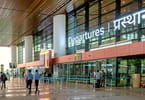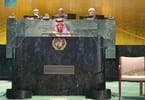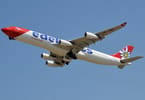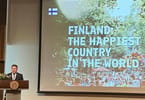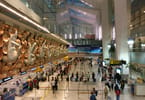Gone are the days when Warsaw’s urban landscape garnered the aesthetic appeal of a shot of vodka on a bare plastic table. Thanks to a two-decade-old frenetic construction boom, Poland’s capital has gone from an architectural wasteland to the propitious showpiece of the “New Europe”.
While a sagging global economy may well impact future projects, the recent years of relative fast growth have already left an imprint on the Polish capital.
In the years after World War II, when nearly 90 percent of the Warsaw’s western end was reduced to rubble, the city was rebuilt to model a centralized Soviet scheme. Apart from the meticulously reconstructed Old Town, the communist-style city planning resulted in a host of somber block-shaped housing structures, the piece de résistance being the monolithic cake-shaped Palace of Culture and Science, which still serves as the city’s oddly anachronistic centerpiece.
But rapid economic growth following the systemic changes resulted in a demand for debonair design that over the past decade triggered an exciting explosion of new-age structures.
And the world noticed, with tourism being a key beneficiary of the newly-styled Polish capital. Warsaw Tourist Office and Ipsos figures reveal the Polish capital registering an all-time high of 9 million tourist arrivals in 2008, of which 3.5 million were foreign visitors. This marks a jump of nearly 50 percent in foreign arrivals since Poland’s integration with the European community four years ago.
Escalating tourist numbers and a new architectural look for the Polish capital are just the start. An intense construction drive and the fine-tuning of business tourism infrastructure will keep up the pace of expansion as this country prepares to co-host the prestigious UEFA euro soccer championship in 2012. With a state-of-the-art football stadium and a spate of new towers and residential structures, Warsaw continues to polish up its image in the eyes of Europe.
Warsaw’s swelling cityscape now boasts a host of sleek skyscrapers, several high-rise commercial buildings, and a forest of visually pleasing commercial sites and culinary establishments.
The sea change in Warsaw’s urban fabric began at the cusp of the new millennium with the completion of the 42-storey Warsaw Trade Tower, commissioned by Korea’s Daewoo Corporation. Completed in 2000, the 164-meter-high mixed-used tower enjoys the distinction of being the city’s second tallest building, usurped only by the landmark dubbed Stalin’s Rocket, another name for the massive Palace of Culture.
Next on the list of high-rise buildings was the InterContinental Warsaw hotel, erected in 2003 by Austrian developer Warimpex on the plans of local architect Tadeusz Spychala. Quickly following suit and also a five-star hotel was the Westin Warsaw, a 20-floor pink brick and glass edifice with 361 rooms. The Hilton Hotel and Conference Centre, a glazed 50-million euro complex was finished in 2007, boasting 330 guest rooms and some two dozen conference facilities, a casino and the city’s largest fitness and spa center.
Poland’s largest metropolis also saw the development of state-of-the-art shopping centers and high-concept business buildings with less cloud-reaching ambitions, but equal architectural pizzazz. Leading the pack is the ellipsoid-shaped Metropolitan building, standing at the northern edge of the historic Pilsudskiego Square, the royal Saxon Gardens and the National Opera House.
“The aim was to create a thoroughly modern counterpart to the neighboring historical buildings – matching their height, massing and materials – without resorting to pastiche,” reads the master plan for the imposing seven-storey structure that was drawn up by award-winning British architect Sir Norman Foster and his London-based design firm Foster and Partners.
Foster partnered with Polish JEMS Architekci, and after long-drawn negotiations with historians and conservation specialists, the 80 million euro structure was financed by Hines Polska and the Emerging Market Fund, and was completed in 2003. The result is a bold architectural statement linking three buildings with a 50-meter diameter circular courtyard that delivers a jolt of new-age chic with its glass-and-concrete exterior.
Embodying the essence of new-age design is Warsaw’s latest cathedral of commerce, the Zlote Tarasy, or Golden Terraces, developed by the ING Real Estate firm and Los Angeles-based The Jerde Partnership in 2007.
Located right next to the transport hub of Warsaw’s central railway station the mega mall’s impressive wave-shaped glass dome acts as a homing beacon for retailers like The Body Shop, the Zara and Stradivarius clothing chains and the American music-themed Hard Rock Cafe.
“The greatest architectural challenge was the design of the undulating glass roof, which is one of the largest in the world with more than 4,700 individual panes of glass,” explains David Rogers, senior designer and partner at The Jerde Partnership, who lead the design team on this spacious conglomerate.
“Each triangular piece of glass was individually made and shaped to fit into its respective steel slot, similar to assembling an intricate but fragile puzzle. The shape and style of the undulating glass roof was inspired by the tree canopies in Warsaw’s historic parks.”
The fast-paced modernization, coupled with the then availability of capital is credited for the explosive growth in Warsaw’s real estate development scene. To broaden the scope of interest of in the imminent architectural landmark, developers have also enlisted the services of brand-name architects like Daniel Libeskind, the Polish-born American architect who masterminded New York’s Ground Zero and Berlin’s contemporary Jewish Museum.
For his hometown, Libeskind has designed Zlota44, a soaring 192-meter tall condominium to be built in center of Warsaw by 2010. The angular glass-clad tower, commissioned by the Luxembourg-based Orco Property Goup, will be home to 251 luxury apartments and a slew of state-of-the-art amenities, including a 25-meter long indoor pool.
The modernization across Warsaw’s skyline is closely linked to Poland’s strong economic performance and rising foreign direct investment over the past decade. In 2007, a study of cross-border investment flows commissioned by Ernst & Young and the Polish Information and Foreign Investment Agency (PaIiIz) ranked the country as the world’s seventh most desired destination for FDI, drawing over 12 billion euro to the capital.
Undoubtedly, the spur in investment in high-profile architectural projects and the ensuing buzz of business activity has contributed to turning Warsaw, once again, into a newly-styled business and tourism destination.
Budapest-born Anna J. Kutor enjoys enriching her life with eye-opening experiences as well as filling her living space with abstract objects and images. A journalist and photographer, she takes pleasure in discovering the details of cities: a bohemian cafe boasting the creamiest coffee or discovering a hidden courtyard with an avant-garde statue. These days, based in Warsaw, she writes about travel, food and design.
WHAT TO TAKE AWAY FROM THIS ARTICLE:
- Apart from the meticulously reconstructed Old Town, the communist-style city planning resulted in a host of somber block-shaped housing structures, the piece de résistance being the monolithic cake-shaped Palace of Culture and Science, which still serves as the city’s oddly anachronistic centerpiece.
- Embodying the essence of new-age design is Warsaw’s latest cathedral of commerce, the Zlote Tarasy, or Golden Terraces, developed by the ING Real Estate firm and Los Angeles-based The Jerde Partnership in 2007.
- The sea change in Warsaw’s urban fabric began at the cusp of the new millennium with the completion of the 42-storey Warsaw Trade Tower, commissioned by Korea’s Daewoo Corporation.




